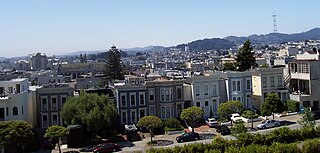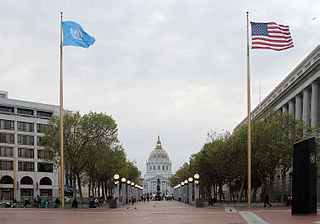
The Civic Center in San Francisco, California, is an area located a few blocks north of the intersection of Market Street and Van Ness Avenue that contains many of the city's largest government and cultural institutions. It has two large plazas and a number of buildings in classical architectural style. The Bill Graham Civic Auditorium, the United Nations Charter was signed in the Veterans Building's Herbst Theatre in 1945, leading to the creation of the United Nations. It is also where the 1951 Treaty of San Francisco was signed. The San Francisco Civic Center was designated a National Historic Landmark in 1987 and listed in the National Register of Historic Places on October 10, 1978.

Japantown, also known historically as Japanese Town, is a neighborhood in the Western Addition district of San Francisco, California. Japantown comprises about six city blocks and is considered one of the largest and oldest ethnic enclaves in the United States.

Ralston Hall Mansion located in Belmont, California, was the country house of William Chapman Ralston, a San Francisco businessman, a founder of the Bank of California, and a financier of the Comstock Lode. It is an opulent Italianate Villa, modified with touches of Steamboat Gothic and Victorian details. It is a California Historical Landmark and is designated a National Historic Landmark. It is now part of Notre Dame de Namur University.

This is intended to be a complete list of the properties and districts on the National Register of Historic Places in San Francisco, California, United States. Latitude and longitude coordinates are provided for many National Register properties and districts; these locations may be seen together in an online map.

Architectural Resources Group is a firm founded in 1980 by Bruce Judd and Steve Farneth in San Francisco, California. It began by providing professional services in the fields of architecture and urban planning with particular expertise in historic preservation. In 2000, David Wessel, a Principal of ARG, founded a separate conservation-contracting division, ARG Conservation Services which operates under the same roof as ARG. By 2005, the firm had expanded to a full-service architecture firm with 50+ employees. ARG also opened offices in Pasadena serving Southern California, and Portland, Oregon, serving the Pacific Northwest.

The First Unitarian Church of San Jose is located at 160 North Third Street in downtown San Jose, California, across from St. James Park, and was designed in "Richardsonian Romanesque" style by architect George Page, who also designed the Hayes Mansion. Local historian Linda Larson Boston called the building, “One of a handful of American churches patterned after Unitarian churches of Transylvania, it features a large triple-arched stained glass window on the facade, multiple domes and cupolas, and both round and square towers,” in her pamphlet, Highlights of San Jose, California’s St. James Park and Environs. The congregation purchased the site in 1888, and the cornerstone was laid in a ceremony on September 23, 1891. The building is registered on both the list of National Register of Historic Places and the list of California Historical Landmarks.
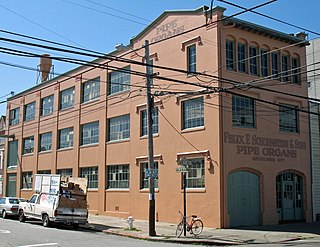
Schoenstein & Co. formerly known as Felix F. Shoenstein and Sons, is the oldest and largest organ builder in the western United States. It was founded in 1877 by Felix F. Schoenstein in San Francisco, California; the company is now based in Benicia, California.

Henry William Cleaveland was an American architect based in New York, New York, and then San Francisco, California, and Portland, Oregon. He was one of the founding members of the American Institute of Architects, and several of his works have been listed on the National Register of Historic Places. His works include Ralston Hall, a National Historic Landmark in the San Francisco Bay Area, the original Palace Hotel in San Francisco, and the Bidwell Mansion in Chico, California.
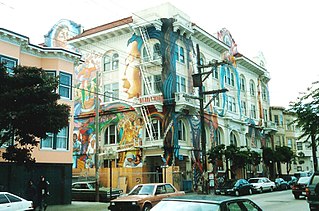
The Women's Building is a women-led non-profit arts and education community center located in San Francisco, California, which advocates self-determination, gender equality and social justice. The four-story building rents to multiple tenants and serves over 20,000 women a year. The building has served as an event and meeting space since 1979, when it was purchased by the San Francisco Women's Center. The building is shielded from rising real estate costs in the Mission District because that group has owned the building since 1995.

The Abner Phelps House is one of the oldest private residences in San Francisco, constructed in approximately 1850 by Abner Phelps and his wife Augusta Roussell with pre-constructed house parts. It is located at 1111 Oak Street just west of Divisadero Street in San Francisco's Haight Ashbury district. The house is not open to the public, and as of 2019 is the location of a private business.

Our Lady of Guadalupe Church is a Roman Catholic church in San Jose, California, located in the Mayfair neighborhood of East San Jose. It is historically important for its association with Californian civil rights activist César Chávez, who attended the church and conducted labor and community organizing activities out of the old church building, which now serves as the parish hall under the name McDonnell Hall. The building was designated a National Historic Landmark in 2016.
The Big Five of Bayview were community leaders and political activists from the Bayview and Hunters Point districts in San Francisco who were instrumental in backing the India Basin and Hunters Point Redevelopment Projects to completion in the 1960s and 1970s.

The Old San Francisco Mint is a building that served as the location of the San Francisco branch of the United States Mint from 1874 until 1937. The building is one of the few that survived the great 1906 San Francisco earthquake and resulting fire. It was designated a National Historic Landmark in 1961, and as a California Historical Landmark in 1974.

Henry Geilfuss also known as Heinrich Geilfuss, was a German-born American architect. He designed approximately 400 homes in the San Francisco Bay Area.
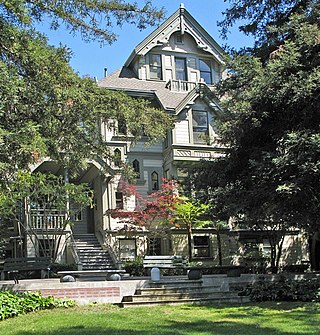
Treadwell Mansion and Carriage House, is a historic mansion with carriage house built in c. 1875 in the Rockridge neighborhood of Oakland, California, U.S.. The two buildings used to be part of the campus for California College of the Arts, from 1922 until 2022. The Treadwell Mansion and Carriage House has been listed on the National Register of Historic Places since July 15, 1977; listed as a California Historical Landmark since July 15, 1977; and listed as an Oakland Designated Landmark under the name "Treadwell Hall" since August 5, 1975. It is also known as the James Treadwell Mansion, Treadwell Hall, and Macky Hall.








